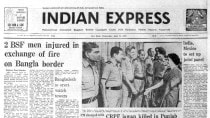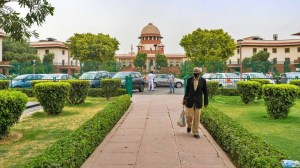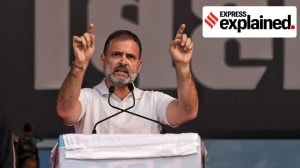- India
- International
Bandwidth is the demolisher of imbalances, a great leveller: A P J Abdul Kalam
Edited excerpts of then President A P J Abdul Kalam’s speech on December 20, 2005 at ‘The Indian Express’ India Empowered summit.
 A P J Abdul Kalam
A P J Abdul Kalam
The total land area of India is around 3.3 million square km with 7,000 km of coastline. The altitude of the country varies from the sea level to 8,600 meters. The entire area is spread into deserts, hilltops, mountains, sea shores, islands, valleys and plains. Out of the billion-plus population in the country, 70 per cent live in 6,00,000 villages. We need a societal transformation and sustainable development for our growth. These two aspects are realisable in a time-bound manner only through a knowledge society, which alone will empower the entire nation. India has the potential to become a knowledge society. Electronic and knowledge connectivity is the key to realise this goal. Connecting a billion people throws up multiple challenges.
[related-post]
When the world was moving from the industrial to information and knowledge era, we witnessed a changing pattern in the sectoral share of GDP and the number of people employed in each sector. The percentage of people employed in agriculture has come down between 1979 and 2005 from 64 to 54 per cent.
Simultaneously, the percentage of people employed in manufacturing has gone up from 15 to 19 per cent and in the service sector from 20 to 27 per cent. This trend has to continue and by 2020 our employment pattern should aim at 44 per cent in agriculture, 21 per cent in manufacturing and 35 per cent in service sectors. The displacement of 10 per cent people from agriculture sector has to be facilitated through skill enabling for undertaking value-added tasks in the rural enterprises so that migration to urban areas is reduced. Instead of persons from rural areas going to urban towns in search of jobs in manufacturing and services sectors, Pura (Providing Urban Amenities in Rural Areas) facilitates the creation of employment in rural areas itself. Pura achieves this by providing physical, electronic and knowledge connectivities to a cluster of villages, thereby leading to their economic connectivity and prosperity.
The core of empowerment for prosperity of one billion people is the connectivity and partnership between governmental and multiple institutions in the public and private domains. The strength of this partnership for collaborative growth and economic prosperity is facilitated by the free flow of knowledge and information in a seamless manner, cutting across levels and boundaries, embracing all walks of life in the three sectors of the economy: agriculture, manufacturing and services. In the proposed model, the inter-connectivity between these three sectors of the economy is brought about by four grids: namely, the knowledge grid, rural grid, health grid and governance grid. Each grid is a system of multiple portals.
India is now in the process of creating virtual universities and institutions for knowledge-sharing, dissemination and reuse. While it is known that virtual universities provide us with technologies of the future and the most economic way of scaling high-quality education in the country, they are no substitute to campus-based education. The challenge before the virtual universities is to provide the best of both worlds. In this process, we could plan an optimum mix of direct contact hours between students and teachers and also amongst students themselves. These interactions should also be used as a platform to excite students to take to learning in the new paradigm. In the world of virtual universities, equitable access to all its participants is the primary goal.

The three phases of learning are the lectures, library and laboratories. They require increasing bandwidth from a few hundred kilobytes for the lectures to a few megabytes for the formal digital libraries and the informal world of knowledge from the internet, to gigabits of connectivity for remote laboratories in the world of high-precision science and engineering. As bandwidth becomes cheaper and available in abundance, universities should be able to run remote instruments and facilities as complex as nuclear magnetic resonance and wind tunnels. This will ultimately provide equitable access to the entire education system beyond just the lectures and the lecturers. Thus bandwidth is the demolisher of imbalances and a great leveller in the knowledge society.
Now I would like to discuss the health grid. Through its Insat network, Isro has connected 25 major hospitals in the mainland. From there, they are providing telemedicine connectivity to remote areas, including our islands. The mission of telemedicine is gaining momentum and will spread to all the equipped primary health centres in the country, medical colleges and research institutions in due course. We need to establish a health grid, connecting the various healthcare institutions with regard to the super-speciality and general medicine areas. Also healthcare-training institutes and medical research institutions must be
networked to the health grid. This will enable unique case studies and experiences to be exchanged.
Now I would like to take up the e-governance grid. Good governance is being recognised as an important goal by many countries across the world. An important dimension of the internet’s potential is the possibility of providing services anytime, anywhere. Citizens are being perceived as customers and clients.
I visualise an election scenario where a candidate files his nomination from a particular constituency. Immediately, the election officer verifies his authenticity from the national citizen ID database. His education credentials come from the university records. His track record of employment comes from various employers with whom he had worked. His income and wealth resources come from the income tax department, and other sources. His property record comes from land registration authorities across the country. His credit history comes from various credit institutions like banks. His civic consciousness and citizenship behaviour comes from the police crime record. His legal track records come from the judicial system. All the details arrive at the computer terminal of the election officer within a few seconds automatically by the act of e-governance software agents which crawl across the various state and Central government web service directories through the network grid and collect the information automatically and present the facts in real-time without any bias. The election officer sitting at the remote block of the country decides on the spot and the election process starts. Voters vote from home through virtual polling booths.
For providing knowledge connectivity to the Pura complexes, village knowledge centres will act as the frontline delivery system. I visualise the establishment of a village knowledge centre in the village panchayat to empower the villagers with knowledge and to act as a local centre for knowledge connectivity within the overall framework of Pura. The village knowledge centre should provide the essential data required for the targeted population such as farmers, fishermen, craftsmen, traders, businessmen, entrepreneurs, unemployed youth and students. It has to be acquired by visiting the village, talking to the rural people, by understanding their requirement and core competence. Meteorological data for farmers and fishermen has to be area specific. Local relevance of information offered is essential.
To maximise the synergy between the grids, leading to maximisation of the GDP and productivity, there is a need for inter-grid connectivities, which may be called the societal grid. Knowledge-sharing, utilisation and reuse is vital by all constituents of the society for promoting non-linear growth.
EXPRESS OPINION
Apr 25: Latest News
- 01
- 02
- 03
- 04
- 05










































